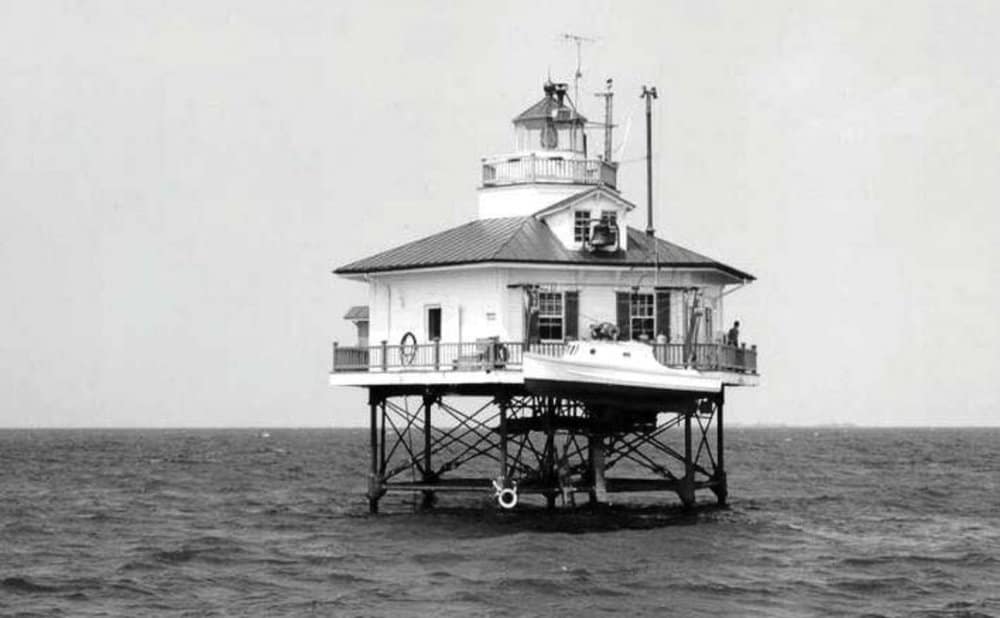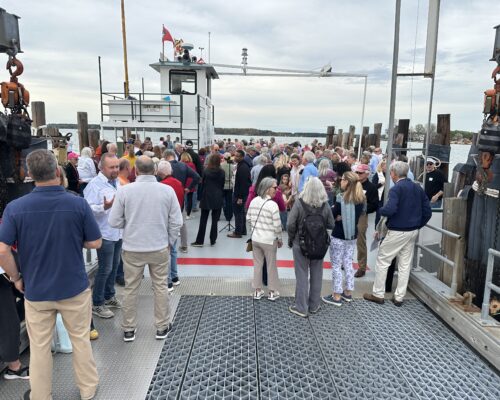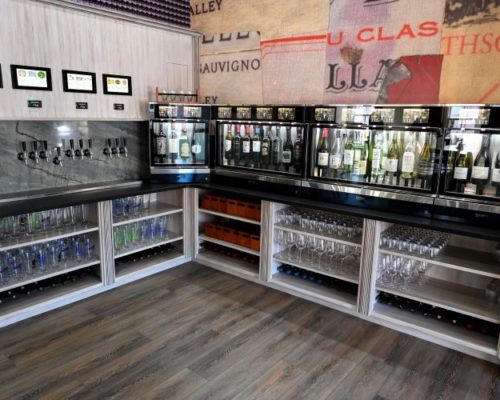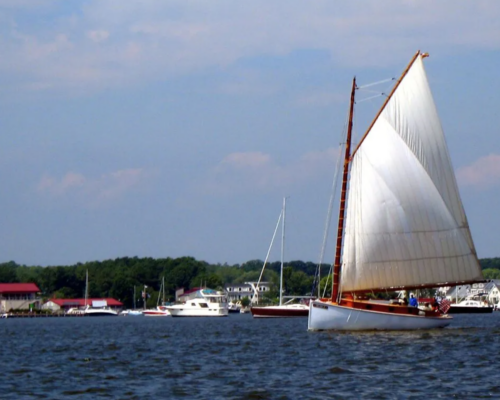Rum runners, rockets and (maybe) bloody murder.
You can see them all over the Chesapeake—buoys, daymarks, unmanned lights, and even lighthouses—all guiding ships day and night. The lighthouses draw the occasional tourist or photographer, but the rest are just there, doing their job, day after day. They are important, of course, even vital, but they have no real personalities or history.
Appearances, however, can be deceiving.
The Holland Island Bar Light on Kedges Strait opposite Point Lookout is not much to look at, just a couple of range marks and an automated light on a rusty steel frame that looks too big for it. Several birds are usually nesting or just perched impassively, secure in the knowledge that no one will bother them in this isolated place. The lapping of the waves and the occasional cry of the birds are the only sounds that break the lifeless silence. People on passing vessels may glance at the light just long enough for a quick navigational fix, then turn away.
Despite its present appearance, however, the Holland Island Bar Light has a past touched with violence, death, and mystery.
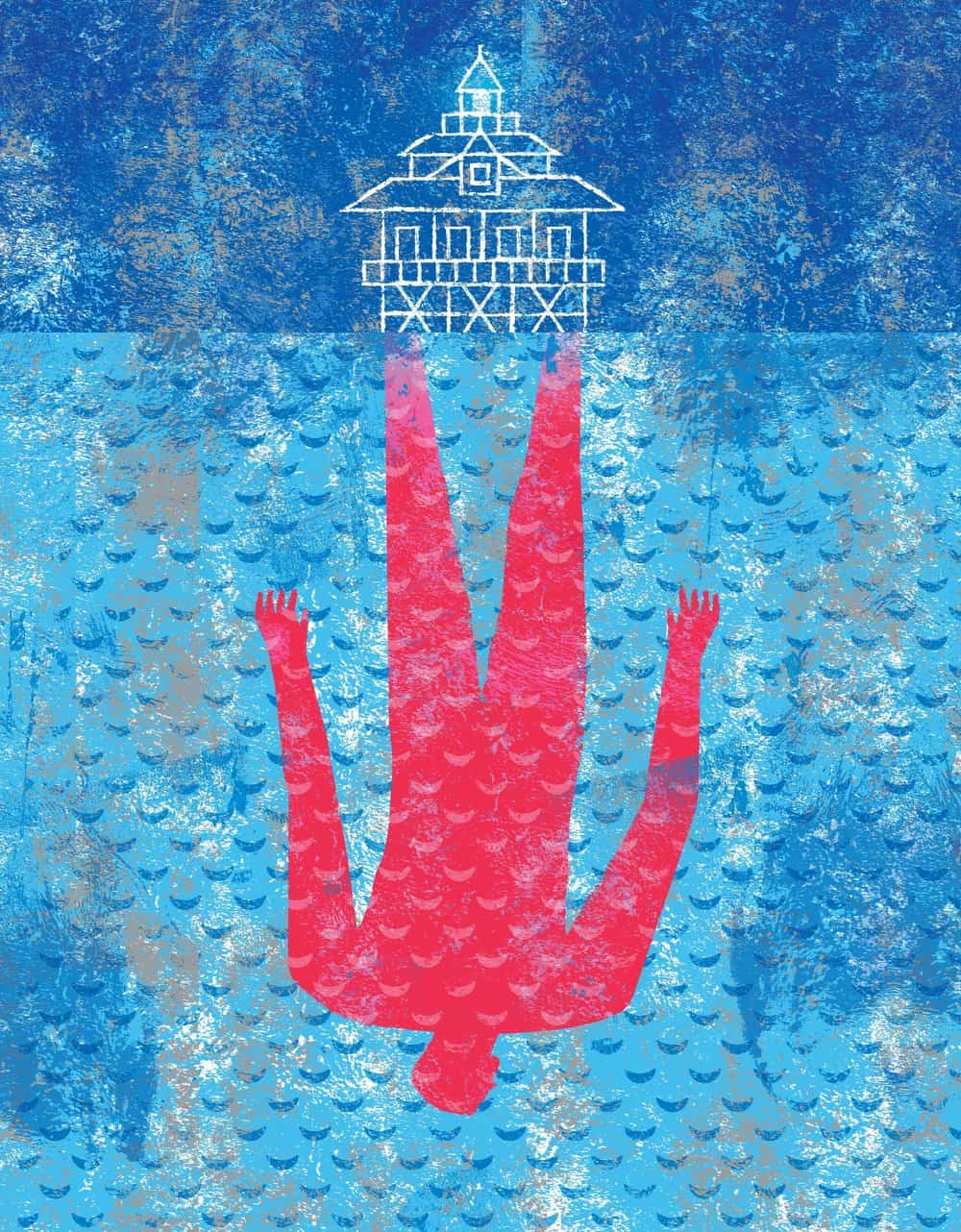 Illustration by James O’Brien
Illustration by James O’Brien
You see, the Holland Island Bar Light was once a fully manned hexagonal wood frame screw pile lighthouse, marking Kedges Strait with the nearby Solomon’s Lump Light. The story begins on the night of March 11, 1931, when Henry Stirling, keeper of the Solomons Lump Light peered westward across Kedges Strait. Through the darkness, and just a few miles farther out in the Bay, was the Holland Island Bar Light and its keeper, Stirling’s friend, Ulman Owens. Like the lighthouses they cared for, both men were employed by the US Lighthouse Service to keep the lights lit for safe navigation on the Chesapeake. On this night, however, the Holland Island Bar Light was inexplicably dark. Stirling feared something was wrong, maybe something serious.
He radioed the Somerset County Sheriff, Luther Daugherty, who set off for Holland Island Bar Light the next day from Crisfield with the county magistrate and a doctor. The officials from Crisfield called out as they approached, but there was no response and no sign of activity. The small boat assigned to the light was in place, indicating that Owens should be there. But where?
When they arrived, they found the door open and an eerie silence from inside the lighthouse. It looked as if the light keeper might have fallen overboard somehow, but when they entered, they saw the terrible truth.
There, sprawled on the floor was Ulman Owens. Most of his clothes had apparently been torn from his body. The room had been ransacked, with overturned furniture, papers, and broken crockery everywhere. But the worst part was the blood. Splatters and streaks of red were everywhere, and near Owens was a bloody knife. The doctor examined the body, but could find no wounds other than a bruise. So where did the blood come from? The doctor’s initial thought was that Owens had had a fit or a seizure of some kind. Owens had been alone in the station due to the illness of his assistant. The station’s logbook entries stopped just before the light outage was reported and gave no hint of
any problem.
As police tried to sort out what had happened, rumors began to spread. There was a newspaper report that some sort of unspecified drugs had been found at the lighthouse, but that proved false. Then there were reports of a mysterious ship with no running lights coming from the direction of the light on the night Owens died, but this turned out to be a boat towing another boat and had no connection. Unfounded rumors that the police had made an arrest and obtained a confession were breathlessly repeated.
The most persistent rumor involved vengeful rum runners. In 1931, Prohibition was going strong and the Chesapeake Bay was crisscrossed by rum running boats smuggling liquor to thirsty markets in Baltimore, Washington, and Annapolis. The lighthouse keeper, so the theory went, was in a great position to observe the comings and goings of the runners up and down the bay, out from the Crisfield area, and towards the mouth of the Potomac. Maybe he had been informing on the booze boats to the Coast Guard. With all the money and danger involved in rum running, and the connection with organized crime, this scenario was not far-fetched.
The possibility of a Prohibition connection, and of a crime committed on a federal facility, caused the Bureau of Investigation (later to become the FBI) to start its own investigation. Their first step was to exhume Owens’ body and conduct an autopsy. To add to the pressure, Owens’ relatives were convinced there had been foul play and scoffed at the idea that the death might have been from natural causes. A finding of foul play would mean that Owens had died from the circumstances of his employment, and his family would be entitled
to benefits.
The autopsy revealed that Owens had a fractured skull and an enlarged heart, as well as the bruise found earlier. After some more investigating and witness questioning, the local and the federal law enforcement investigators came to the same conclusion: death by natural causes, just as the original doctor had speculated. Owens, it seemed, was the victim of a heart attack or some sort of fit that caused him to convulse in a way that caused his bruise, his fractured skull, and the condition of the room. What about the blood without a visible wound? That was possibly a nose bleed coupled with the thrashing about.
This conclusion, of course, pleased no one, and there were calls for even more investigation, but it was not to be. The final decision stood; death by natural causes.
But there was an unsettling footnote to the case. Later that same year, prohibition agents broke up a large rum running syndicate on Taylor’s Island, just a few miles north of the light. As one of the bootleggers was brought in to jail, he grumbled that the arresting officers would “get what the lighthouse keeper got….We did that.” When pressed, the bootlegger said he was just kidding and he hoped they’d forget it. No other evidence was found, and the bootlegger denied any knowledge of the lighthouse keeper; just another loose end in a case that had more than enough already.
The U.S. Lighthouse Service became part of the U.S. Coast Guard in 1939, and in 1957, the lighthouse was attacked by the Navy. Yes, a flight of Navy Skyraiders flew down the bay from Atlantic City for a nighttime, practice rocket attack on the Hannibal, a sunken target hulk four miles away from the Holland Bar Light. Things got confused, however, and, in the darkness, the pilots attacked the lighthouse instead.
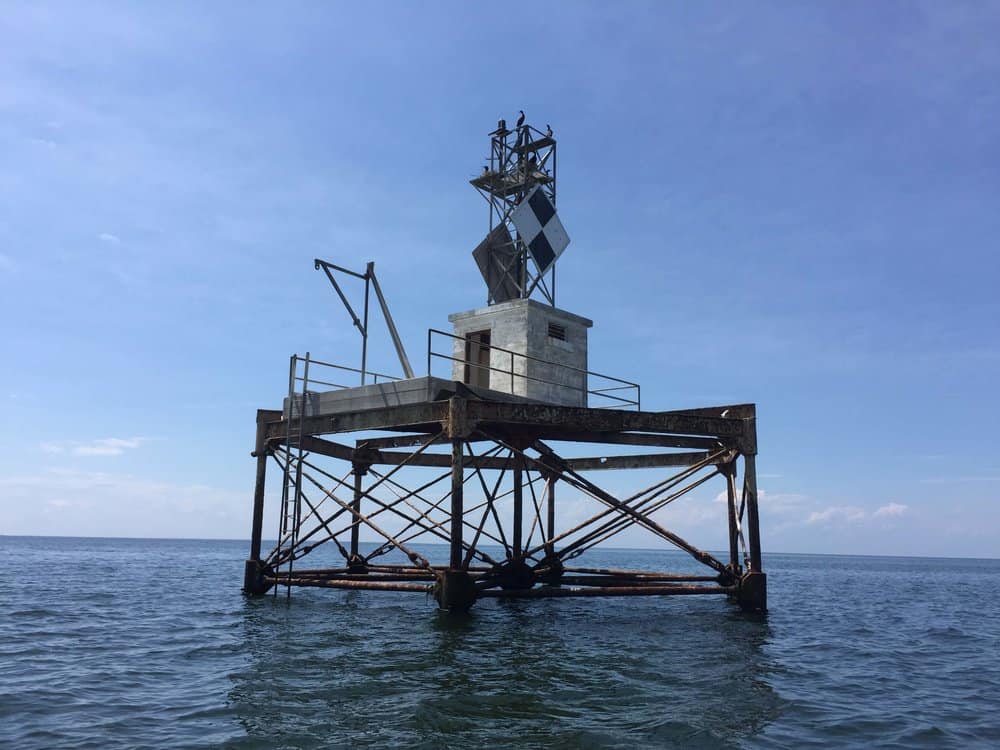 The light today. Photo: Shawn Ridgely.
The light today. Photo: Shawn Ridgely.
Fortunately, the rockets were non-explosive practice types. No one was hurt, but several holes were torn in the siding of the lighthouse and parts of the steel supports were broken and bent. The light, however, remained lit throughout the ordeal. The pilots were ordered to land at Patuxent to get them on the ground as soon as possible. There was some scuttlebutt about possible disciplinary action against the pilots, but in the end, everyone was so embarrassed that the matter was quietly dropped.
In 1962, the Coast Guard, as part of their long-range automation efforts, removed the lighthouse down to its screw pile foundation, and replaced the light with an unmanned, automated model.
Today, a mariner passing up or down the bay probably pays little attention to the small, unmanned signal squatting in what looks like the middle of the bay, roughly opposite Point Lookout. If the mariner looks carefully, though, he can still see the old lighthouse’s support frame underneath, all that remains of the lighthouse that saw the mysterious death of Ulman Owens. The old lighthouse is gone, but the mystery remains. The birds perch silently, like mourners at a perpetual funeral, watching the ships plying the bay, and sharing the remains of the lighthouse with the restless ghosts of its past.

